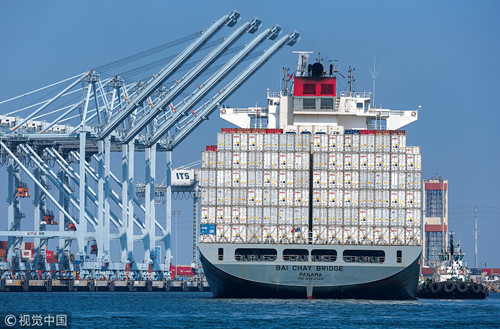China's development offers opportunities for the world


A cargo ship into the Port of Long Beach in Long Beach, California, US, April 4, 2018. [Photo/VCG]
Chinese President Xi Jinping's speech at the Boao Forum for Asia confirming the country will open up further indicates the country will bring more dividends to the world via this policy, according to a post on the National Bureau of Statistics website Thursday.
In truth, China has been the main growth engine for the world economy. China's GDP accounted for 14.8 percent of global GDP in 2016, up from 12.5 percent in 2013. Over these four years, the country achieved an average growth rate of 7.2 percent, much higher than the United States' 2.1 percent, the eurozone's 1.2 percent and Japan's 1.1 percent.
Chinese GDP in 2017 should have accounted for 15.3 percent of global GDP, based on World Bank estimates the world's economy should have grown by 3 percent. In addition, the Chinese economy's contribution to the world's economic growth would be 34 percent.
Between 2013 and 2016, Chinese consumption contributed 23.4 percent to global consumption growth, while the US' contribution rate, the Eurozone's contribution rate and the Japanese contribution rate came in at 23 percent, 7.9 percent and 2.1 percent respectively.
Chinese citizens made 130 million trips overseas, up by 7 percent according to the NBS. Those who travelled abroad spent a total of $115.29 billion, up 5 percent. In 2016, Chinese tourists spent an average of $13,000 in the United States, resulting in a daily revenue of $97 million for the country. China's imports have also been a main force for balancing the world economy, the NBS post said.
In 2016, China's imported goods and services accounted for 9.7 percent of the global total, up from 8.4 percent in 2011. During these six years, percentages of the imported goods of services from the United States, the eurozone and Japan over total global imports decreased by 0.4 percentage points.
According to the WTO, China's import growth in the first 10 months of 2017 was 10.4 percentage points, 8.1 percentage points, 7.6 percentage points and 6.5 percentage points higher than growth of the United States, Germany, Japan, and the entire world respectively. In the first three quarters of 2017, China's import percentage over the global total increased to 10.2 percent and import growth contributed 17 percent to global import growth.
Chinese enterprises have invested $14.36 billion in non-financial sectors in 59 countries involved in the Belt and Road Initiative in 2017. Chinese enterprises signed $144.32 billion in contracts with 61 countries involved in the initiative, up 14.5 percent year-on-year and gaining revenue of $85.53 billion, up 12.6 percent year-on-year.
According to the US Department of Commerce, the US's export of goods and services to China generated 910,000 jobs in the country in 2015.
MOST POPULAR
- 1 China to give visa-free treatment to another 9 countries
- 2 China fully opens manufacturing sector to foreign investors in landmark opening up move
- 3 China's import expo attracts record-breaking participating countries, exhibitors
- 4 China's door opening even wider to foreign visitors, businesses
- 5 China revises rules to ease foreign strategic investment in listed firms
Editors' Picks
 Infographic:
China's public holidays for 2025
Infographic:
China's public holidays for 2025
 Infographic:
Basic facts of APEC
Infographic:
Basic facts of APEC
 Infographic:
Wrapping up the 7th CIIE: Data recap
Infographic:
Wrapping up the 7th CIIE: Data recap




